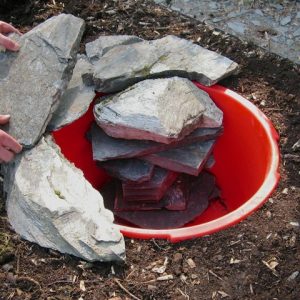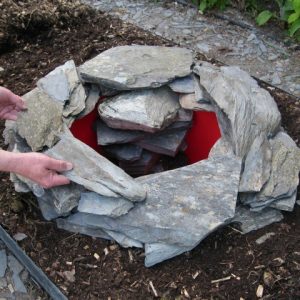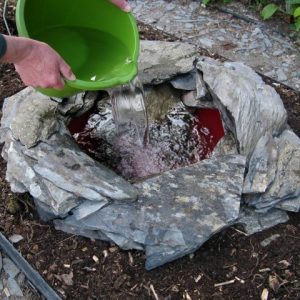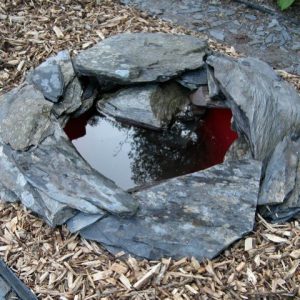Outdoors or under cover, a small pond is the surest way to bring myriad wild life – and all its benefits – into your growing space.
Ponds add life – it’s as simple as that. Not only can they look good, but even a small pond will dramatically increase the range and kind of wildlife your garden first attracts, and then keeps around. Adding a pond is akin to parachuting in a dynamic, self-contained aquatic ecosystem as the beating heart of your garden or allotment, helping keep the broader ecosystem across your patch in healthy balance.

Don’t assume ponds are just for gardens; they can work their magic inside larger greenhouses and polytunnels, too. Some of the most innovative and earth-friendly greenhouse growers I know have life-filled ponds nestled in among their plants.
A pond is one of nature’s bustling interchanges, where life teems. Some wildlife will spend its whole existence submerged, while other species, such as frogs and toads, use ponds to cavort and breed before returning to drier land. Many head-turning insects find ponds irresistible: adult dragonflies and damselflies feed on smaller insects breeding in a pond, and will lay their own eggs there, too. Alderflies, beetles, water boatmen, pond skaters, caddis and mayfly larvae, leeches and water snails are other obvious-to-the-eye water dwellers.
Birds, mammals and insects such as bees visit ponds to drink or take a dip. More insects whose larvae live in water means more airborne food for spiders, for adult damselflies and dragonflies, and for insect-catching bats and birds such as flycatchers and swallows. Adding even a modest pond (or three) to your garden, allotment, greenhouse or polytunnel will boost the myriad wild lives that unfold there.
After much procrastination, I’ve finally begun adding ponds to my garden. Perhaps the dragonflies that swoop down from the disused reservoir will stop off a while longer. My garden is terraced, so I’m aiming for one small pond per level. I want ponds that look good, which complement my garden-defining slate walls, which boost wildlife and – crucially – which do not cost me a penny. This is how I made my first one…

1 This 60cm-wide, 33cm-deep plastic ‘sheep lick’ tub was blowing around a field (along with countless others) here in Snowdonia. It’s a perfect repurposed pond-maker, which I checked for leaks first (the red will be subdued by algae once pond life gets underway). I dug a hole to position the tub in the centre of this new 110cm-wide bed, levelled and firmed the base, then checked that the tub was sitting level with the surrounding soil. Standing in the tub to anchor it, I backfilled and firmed soil in around it.

2 To help any wildlife – from hedgehogs to ground beetles – that accidentally falls into the pond to easily get out again, I used reclaimed slate to build a flight of submerged ‘escape steps’ on one side of the tub (bricks, flat stones or broken paving slabs will work equally well). These underwater steps not only help wildlife to clamber out, they also create hidden nooks and crannies which pond-dwellers can inhabit – and retreat to if the local heron calls by. Make sure your escape route is solid and won’t collapse.

3 The stone at the top of the ‘steps’ will sit above the water and has sloping sides where birds and insects can land to drink. I then used lichen-adorned pieces of slate to surround the edge of the tub, hiding it under a 2.5–5cm-wide overhang. It’s worth playing around with the materials you have at this stage, to get a finish where everything fits together well. You can use whatever you have; roof tiles, old bricks or even logs can be used to create an attractive eco-edge.

4 For habitat-max, I layered the slate to create crevices and hollows all around the pond. Those slates next to the tub’s rim will be constantly moist and shaded (water will overflow during rain), and will be a hang-out favoured by toads and newts. In spring and summer the slate will heat up in the sun, hopefully tempting the common lizards and slow worms that abound here to do some sunbathing. The wildlife that’s drawn to the pond will – with any luck – ripple out across and benefit the wider garden.

5 Next comes the fun, splashy bit: filling the pond and injecting it with new life. I used rainwater from my tank, but tap water is fine – it’ll just take a little longer to purify itself. The last bucketful – which I ‘borrowed’ from my neighbour’s small and healthy pond – was used to give my own aquatic ecosystem a kick-start. Don’t fret if you’ve no neighbouring ponds to dip into; wildlife will find yours in far less time than you might imagine. Gnats circled mine an hour after I’d finished it.

6 I decided against planting around the edge of my pond, as it could soon be swamped. I’ve added hornwort (Ceratophyllum demersum) as a submerged oxygenator that’ll provide shelter and egg-laying habitat for pond-dwellers, and help keep the water clear. Don’t add fish; they’ll eat all of the other wildlife you were hoping to attract. If the water level runs low, top it up with rainwater from a butt (don’t use tap water once a pond is established). Not bad for a found plastic tub, some chunks of reclaimed slate, and an ecosystem-making afternoon’s work.
Text and images © John Walker
Find John on Twitter @earthFgardener


